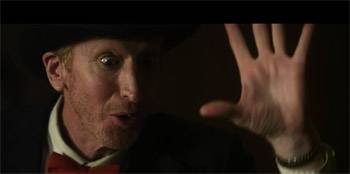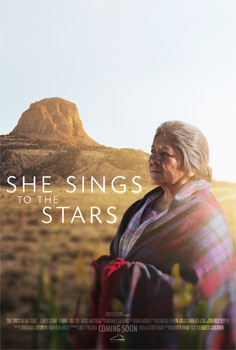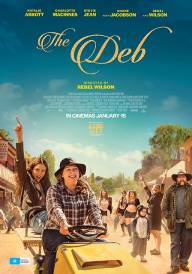Jennifer Corcoran She Sings to the Stars Interview

Jennifer Corcoran She Sings to the Stars Interview
Cast: Larry Cedar, Fannie Loretto, Jesus Mayorga
Director: Jennifer Corcoran
Synopsis: Deadwood's Larry Cedar 'is amazing" (actor Sam Waterston) in Jennifer Corcoran's She Sings to the Stars, premiering March 19 at New York's Queens World Film Festival.
Without water, a Native American grandmother continues to inhabit the desert, both ancient and alien. Her half-Hispanic grandson rushes to 'make it big'. A faded magician finds himself lost at her doorstep.
Written and directed by Jennifer Corcoran and produced by Circeo Films and starring Larry Cedar, Fannie Loretto, and Jesus Mayorga, She Sings to the Stars was named Best Film at the Toronto Independent Film Festival and won Best Actor and Audience Award at the Vermont Film Festival. Expected wide release late 2016.
Mabel is a Native American grandmother who lives alone, tending her drought-ravaged corn in the desert Southwest. Her half-Mexican grandson, Third, dreams of 'making it big' in LA, but his plans change dramatically when he comes to his grandmother's house to collect traditional dolls he hopes to sell for a high price. Lyle is a faded magician from LA traveling with a white rabbit, the promise of a gig and a life-long dream to be able to magically disappear. When his radiator boils over, he is stranded outside Mabel's house. Both men must yield to a timeless rhythm and discover a capacity greater than imagined.
Check out the She Sings to the Stars crowdfunding campaign at seedandspark.com/shesingstothestars
She Sings to the Stars
Trailer
www.shesingstothestars.com
Interview with Jennifer Corcoran
Question: What inspired the creation of She Sings to the Stars?
Jennifer Corcoran: Mabel is a Native American grandmother who lives alone, tending her drought-ravaged corn in the desert Southwest. Her half-Mexican grandson, Third, dreams of 'making it bit' in LA, but his plans change dramatically when he comes to his grandmother's house to collect traditional dolls he hopes to sell for a high price. Lyle is a faded magician from LA traveling with a white rabbit, the promise of one last gig and a life-long dream to be able to magically disappear. When his radiator boils over, he is stranded outside Mabel's house. Both men must yield to a timeless rhythm and discover a creative capacity greater than imagined.
My brother, Jonnie Corcoran and I created Circeo Films, an independent film production company in 2011 with the intention to produce a cycle of films about women. As women, our native feminine voices are too often missing in the story-telling world of film. And we seem to have forgotten the feminine nature of the Earth and our innate relationship to it. I think it is a time when women all over the planet are beginning to sound a different voice, one which seems to have been quiet for a very long time.
I had written a complex screenplay which involves the city of Rome, a little girl, a dog and the upheavals of 1968. My brother said "No," outright, "it's far too ambitious for a first feature, we'll never be able to fund it: three characters, three locations." As his words plunged to the bottom of the Skype connection, I smelled sage brush and saw the desert Southwest.
There is no one single inspiration behind She Sings to the Stars. It grew out of necessity, from a dream, considerable research, volumes of poetry, years spent observing beauty and human behaviour. And asking not only 'what is it to be human?' but 'what it is to be a woman vis à vis what is it to be a woman in a man's world?' What is our collective feminine nature?
Several months after the Skype conversation with my brother, I was visited by Mabel in a dream. She was quite small, very old and sitting on the back of a wooden cart. She said "It is time to sing the song. Listen. It will take you four years." She became the character of the grandmother in She Sings to the Stars, initiating the cycle of films.
I had lived in the Southwest for years and came to know several elders from Third Mesa at Hopi in Arizona. I drew on a life lived with that land, its skies, its animals -- on relationships, a particular love of Hopi values, cosmology and literature and the poetry of Native American women from many different tribes.
One of the threads that weaves through She Sings to the Stars is 'what does it mean to listen'? Can we stop long enough to actually listen to each other, and perhaps more importantly, to listen to something deep within ourselves? The desert offers a quality of silence, a mystery that engages the film-goer in a way that will, hopefully, inspire. My own experience of the desert is of a quiet that thunderously begs you to listen.
 Question: What was the biggest challenge regarding the entire process of She Sings to the Stars?
Question: What was the biggest challenge regarding the entire process of She Sings to the Stars?
Jennifer Corcoran: Financing the film was a substantial hurdle, a 'Catch-22': "You've never made a feature film before. You have no track record. Why don't you make a short?" It reminded me of being 18 again, "You can't have the job because you have no job experience." I was trained as a director in the theatre, worked on stage, in documentary production, made Super-8 shorts, as a literary editor, even home schooled three children (Home schooling three children is more complex than working with a film crew in the middle of nowhere) My brother who is producer has an equally diverse and accomplished background in the business world, with several successful, alternative start-ups. We weren't untested, we weren't 18 and had a great business plan. And we weren't asking for millions; but because we didn't have a track record in the film world, we weren't offering enough investment security. Those days were nerve-wracking. But you learn a lot about presence. And, ironically, it foists you back on yourself to keep refining your vision, both the creative and the business aspect of it.
We were very fortunate to have family, friends, friends of friends put their weight behind us. You just need to find a few people who believe in you. It's heartwarming to discover what people will agree to do with you to make a project that excites them get off the ground. Passion and enthusiasm are infectious.
Personally, the greatest obstacle was doubt. I had to learn to trust the process of not knowing to reveal the way -- to listen to what is not obvious, pay attention to what is elusive and yet to be defined. The process, itself, is the real magic. That may sound trite, but my experience of writing and directing is not one of logic and reason, it's entirely intuitive. I had to remember that children don't plan their game playing, they just play.
Question: Did your script change at all during the filming process?
Jennifer Corcoran: The story stayed intact throughout the shoot; there were minor tweaks to lines found in rehearsal and subtle additions that were breathed into it once we found ourselves in the desert. Once I was in the desert just prior to shooting, I realised the desert, itself, was asking to be a character. With that awareness, the focus of the soundtrack became one that was governed by the sounds of life in the desert -- how it encroaches on the psyches of the outsiders, how it hums in a rhythm with the grandmother who is native to it.
Question: What were the advantages of directing a film you wrote?
Jennifer Corcoran: When I worked as a director in the theatre, directing plays written by others, I always wanted to write and direct my own work. I wanted to work from the inside out, rather than from the outside in. Writing and directing your own work is a very intimate undertaking, much like trying to wake up within a dream or living the relationship between mother and child (the script is the mother)
I had lived and breathed the story for over two years before we went into production. I watched it grow, witnessed myself change with it, and knew that it would continue to evolve once we engaged the actors on set, lived with the crew day and night and moved into the desert.
Question: Can you talk us through the casting process?
Jennifer Corcoran: We auditioned for the parts of Third and Mabel in New Mexico. I had lived with the character of Mabel for two years so was sure I would recognise her as she walked in. But she wasn't appearing.
Our casting director went to a book launch featuring contemporary Native American artists, where she met two artists. They invited her to their tribal feast the following weekend and introduced her to their mother, Fannie Loretto. Fannie had not acted before, but as soon as our casting director saw her, she phoned me to come immediately, "I think I've found Mabel." And she had. Fannie was thrilled by the prospect of being in a film, she auditioned on camera, and we discovered she had an enormous, natural presence onscreen.
I had trawled the internet 6 months prior to conducting auditions in Albuquerque and found a head shot of our actor for Third, Jesus Mayorga. He was quite young in the shot with an intense, almost angry stare. Our casting director had pre-screened him prior to auditions and decided he didn't suit the part well enough to go through to the next round of auditions; but when I didn't find who I was imagining in the auditions, I asked that she call him back. In walked a much older actor, with a softer demeanour but still intense. He was perfect, and he and Fannie bonded immediately. We learned that he had a lot from his own life to draw upon for the character as he is, indeed, an immigrant from Mexico.
The casting of Lyle, the magician, was tricky as I was holding out for a box-office name talent. See the reply to the next question.
Question: Did you have actors in mind whilst you were writing She Sings to the Stars?
Jennifer Corcoran: Tom Waits came to mind again and again when I was writing the part of Lyle. He even waltzed into my dreams. I modelled the character of Lyle on a broken Waits-like magician, collecting old bits of wreckage and trivia, a philosopher junkyard, a peculiar but loveable, undefinable rogue. Though Tom Waits is a musician and a performer - definitely not an actor - we thought we'd see if he would play the part when it came to casting; but we couldn't get past his gatekeepers. I'm happy to say that Larry Cedar offers an amazing and profound performance, one for which I am deeply grateful, so Waits' gatekeepers did us a favour.
Question: Did you have a particular scene in the film which you were most excited to see on the big screen?
Jennifer Corcoran: The magic show, Lyle ("Magical Mister-Y") performs for Mabel in her tiny adobe house in the middle of the desert. The incongruity still delights me each time I watch it: the close ups of their faces, the Native American katsina dolls lining the deep orange adobe walls -- early morning desert sunlight pouring through the tiny windows. And I love the plonkety circus music which accompanies the scene -- incongruous, paradoxical, unpredictable -- ridiculous, yet poignant.
Question: What's next for you?
Jennifer Corcoran: She Sings to the Stars initiates the cycle of films Circeo Films will be producing over the next years. The next film of the cycle will be set in contemporary Ireland with a 28-year old woman as protagonist. The script is nearly completed, but I can't yet let the cat out of the bag. (I am superstitious) The third one is already written, there is a loose foundation for the fourth.
In the meantime, we are launching a crowd funding campaign via the Seed & Spark platform in the middle of March for a month. We are looking to raise funds to be able to pay for distribution. It is the only way the film will be able to be publicly released. (In order to secure distribution contracts, filmmakers have to provide "deliverables" which is all music rights, audio-visual formats for all distribution platforms, legal & insurance costs, etc.)
Small, independent filmmaking is a thirteen-ringed circus designed to offer the unexpected at every corner. Onward!
She Sings to the Stars
Trailer
www.shesingstothestars.com
Interview by Brooke Hunter
MORE





